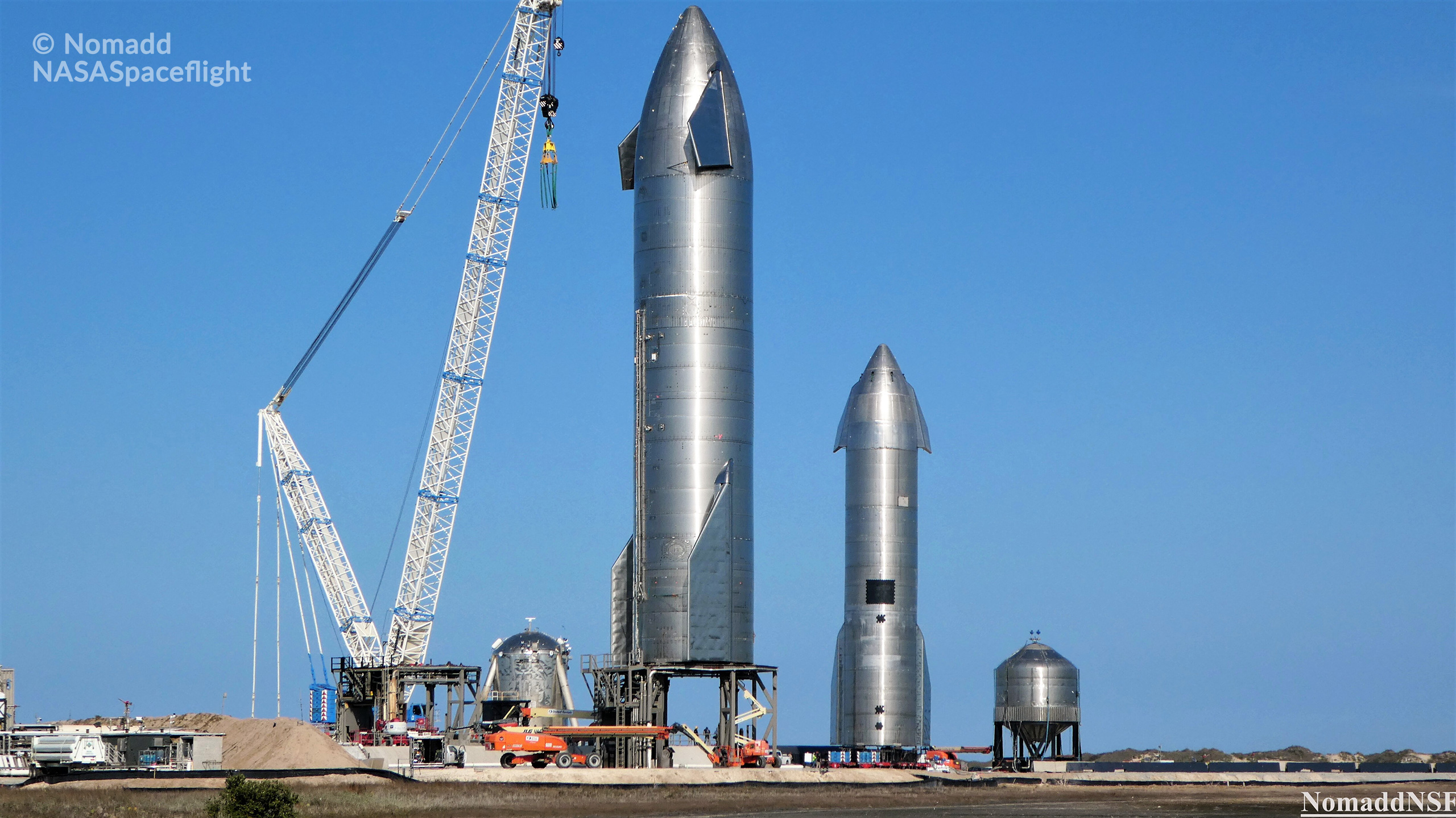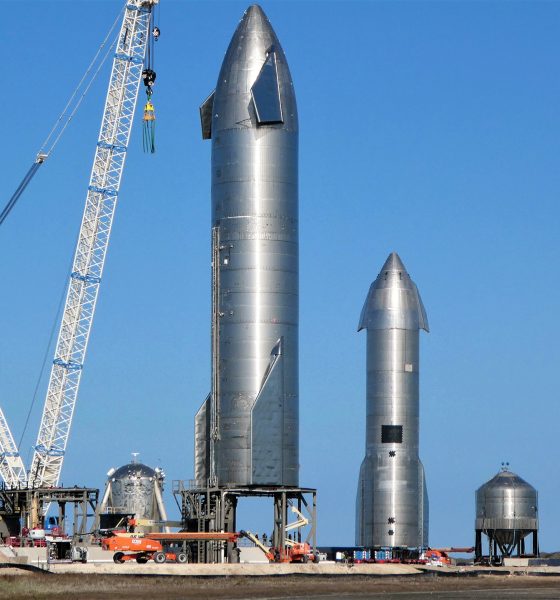

News
SpaceX’s next Starship launch go for Tuesday attempt after licensing dispute
Update 2: Activity at the launch pad suggests that SpaceX is preparing Starship SN9 for a launch attempt as early as 3 pm CST (UTC-6). Today’s launch window lasts until 6 pm CST, enough time for one or more scrub-and-recycle flows in the event of an abort.
Update: Despite signs to the contrary yesterday evening, SpaceX appears to have received an FAA license for Starship SN9’s high-altitude launch debut or is confident that that disputed license is imminent.
According to Mary (aka BocaChicaGal), one of a handful of remaining Boca Chica Village residents, SpaceX has asked the villagers to evacuate for an SN9 launch attempt as early as Tuesday afternoon (CST/UTC-6). To be clear, this is not the first (or second) time residents have evacuated in anticipation of a launch attempt that never came, but there is certainly a chance that this particular instance is the real deal. Stay tuned for SpaceX’s official webcast and unofficial coverage from NASASpaceflight.com and others.
The Washington Post’s Christian Davenport reports that SpaceX’s Starship SN9 FAA launch license is close to being approved, potentially setting the company up for another high-altitude Starship launch as early as Tuesday afternoon, February 2nd.
However, no update on the status of the FAA’s launch license “review” came on February 1st and local Boca Chica residents received a health and safety alert later that evening, likely implying that Tuesday is off the table for Starship SN9’s launch debut.
Delayed for unknown reasons when the FAA withheld a necessary launch license, Starship serial number 9 (SN9) was believed to be ready for an SN8-style launch debut as early as January 25th. According to sources that spoke with The Verge last week, “SpaceX [refused] to stick to the terms of what the FAA authorized” during Starship SN8’s wildly successful launch debut and last-second landing failure, but the FAA refused to comment on the specifics and never offered a material example of how SpaceX violated its SN8 launch license.
Simply put, if the FAA actually had some kind of smoking gun that demonstrated a clear failure by SpaceX to follow the rules it agreed to in good faith, it’s almost impossible to believe that the regulatory agency would withhold that information – especially once it began to be raked over the coals of public perception as the news broke. Why stay silent in the face of harsh criticism if one could easily show that the source was in the wrong?
One possible explanation is a general disinterest or feeling of obligatory detachment at the FAA or its spaceflight wing – often a valuable tactic employed by bureaucratic institutions to operate (or appear to operate) more objectively. On the other hand, it’s also possible that the FAA is splitting hairs to argue that SpaceX refused to “stick to the terms” it laid out, possibly to the point that even the agency itself is aware that publicizing the specifics of SpaceX’s purported sins wouldn’t help its case in the public eye.
It’s fairly easy to imagine that SpaceX – as habitually fast-moving and quick to respond to changing scenarios as it is – may have tweaked Starship SN8’s flight profile as the date got closer and a more detailed picture of vehicle health and weather conditions materialized.
Ultimately, it appears that Tuesday is likely out of the question for Starship SN9’s launch debut. However, SpaceX submitting a safety alert to local residents for possible testing from 8am to 5pm CST (UTC-6) implies that the company could continue testing the SN7.2 test tank, kick off Starship SN10’s first test(s), or even put Starship SN9 through another wet dress rehearsal or static fire. Stay tuned for updates!

News
Tesla FSD fleet is nearing 7 billion total miles, including 2.5 billion city miles
As can be seen on Tesla’s official FSD webpage, vehicles equipped with the system have now navigated over 6.99 billion miles.

Tesla’s Full Self-Driving (Supervised) fleet is closing in on almost 7 billion total miles driven, as per data posted by the company on its official FSD webpage.
These figures hint at the massive scale of data fueling Tesla’s rapid FSD improvements, which have been quite notable as of late.
FSD mileage milestones
As can be seen on Tesla’s official FSD webpage, vehicles equipped with the system have now navigated over 6.99 billion miles. Tesla owner and avid FSD tester Whole Mars Catalog also shared a screenshot indicating that from the nearly 7 billion miles traveled by the FSD fleet, more than 2.5 billion miles were driven inside cities.
City miles are particularly valuable for complex urban scenarios like unprotected turns, pedestrian interactions, and traffic lights. This is also the difference-maker for FSD, as only complex solutions, such as Waymo’s self-driving taxis, operate similarly on inner-city streets. And even then, incidents such as the San Francisco blackouts have proven challenging for sensor-rich vehicles like Waymos.
Tesla’s data edge
Tesla has a number of advantages in the autonomous vehicle sector, one of which is the size of its fleet and the number of vehicles training FSD on real-world roads. Tesla’s nearly 7 billion FSD miles then allow the company to roll out updates that make its vehicles behave like they are being driven by experienced drivers, even if they are operating on their own.
So notable are Tesla’s improvements to FSD that NVIDIA Director of Robotics Jim Fan, after experiencing FSD v14, noted that the system is the first AI that passes what he described as a “Physical Turing Test.”
“Despite knowing exactly how robot learning works, I still find it magical watching the steering wheel turn by itself. First it feels surreal, next it becomes routine. Then, like the smartphone, taking it away actively hurts. This is how humanity gets rewired and glued to god-like technologies,” Fan wrote in a post on X.
News
Tesla starts showing how FSD will change lives in Europe
Local officials tested the system on narrow country roads and were impressed by FSD’s smooth, human-like driving, with some calling the service a game-changer for everyday life in areas that are far from urban centers.

Tesla has launched Europe’s first public shuttle service using Full Self-Driving (Supervised) in the rural Eifelkreis Bitburg-Prüm region of Germany, demonstrating how the technology can restore independence and mobility for people who struggle with limited transport options.
Local officials tested the system on narrow country roads and were impressed by FSD’s smooth, human-like driving, with some calling the service a game-changer for everyday life in areas that are far from urban centers.
Officials see real impact on rural residents
Arzfeld Mayor Johannes Kuhl and District Administrator Andreas Kruppert personally tested the Tesla shuttle service. This allowed them to see just how well FSD navigated winding lanes and rural roads confidently. Kruppert said, “Autonomous driving sounds like science fiction to many, but we simply see here that it works totally well in rural regions too.” Kuhl, for his part, also noted that FSD “feels like a very experienced driver.”
The pilot complements the area’s “Citizen Bus” program, which provides on-demand rides for elderly residents who can no longer drive themselves. Tesla Europe shared a video of a demonstration of the service, highlighting how FSD gives people their freedom back, even in places where public transport is not as prevalent.
What the Ministry for Economic Affairs and Transport says
Rhineland-Palatinate’s Minister Daniela Schmitt supported the project, praising the collaboration that made this “first of its kind in Europe” possible. As per the ministry, the rural rollout for the service shows FSD’s potential beyond major cities, and it delivers tangible benefits like grocery runs, doctor visits, and social connections for isolated residents.
“Reliable and flexible mobility is especially vital in rural areas. With the launch of a shuttle service using self-driving vehicles (FSD supervised) by Tesla in the Eifelkreis Bitburg-Prüm, an innovative pilot project is now getting underway that complements local community bus services. It is the first project of its kind in Europe.
“The result is a real gain for rural mobility: greater accessibility, more flexibility and tangible benefits for everyday life. A strong signal for innovation, cooperation and future-oriented mobility beyond urban centers,” the ministry wrote in a LinkedIn post.
News
Tesla China quietly posts Robotaxi-related job listing
Tesla China is currently seeking a Low Voltage Electrical Engineer to work on circuit board design for the company’s autonomous vehicles.

Tesla has posted a new job listing in Shanghai explicitly tied to its Robotaxi program, fueling speculation that the company is preparing to launch its dedicated autonomous ride-hailing service in China.
As noted in the listing, Tesla China is currently seeking a Low Voltage Electrical Engineer to work on circuit board design for the company’s autonomous vehicles.
Robotaxi-specific role
The listing, which was shared on social media platform X by industry watcher @tslaming, suggested that Tesla China is looking to fill the role urgently. The job listing itself specifically mentions that the person hired for the role will be working on the Low Voltage Hardware team, which would design the circuit boards that would serve as the nervous system of the Robotaxi.
Key tasks for the role, as indicated in the job listing, include collaboration with PCB layout, firmware, mechanical, program management, and validation teams, among other responsibilities. The role is based in Shanghai.
China Robotaxi launch
China represents a massive potential market for robotaxis, with its dense urban centers and supportive policies in select cities. Tesla has limited permission to roll out FSD in the country, though despite this, its vehicles have been hailed as among the best in the market when it comes to autonomous features. So far, at least, it appears that China supports Tesla’s FSD and Robotaxi rollout.
This was hinted at in November, when Tesla brought the Cybercab to the 8th China International Import Expo (CIIE) in Shanghai, marking the first time that the autonomous two-seater was brought to the Asia-Pacific region. The vehicle, despite not having a release date in China, received a significant amount of interest among the event’s attendees.








